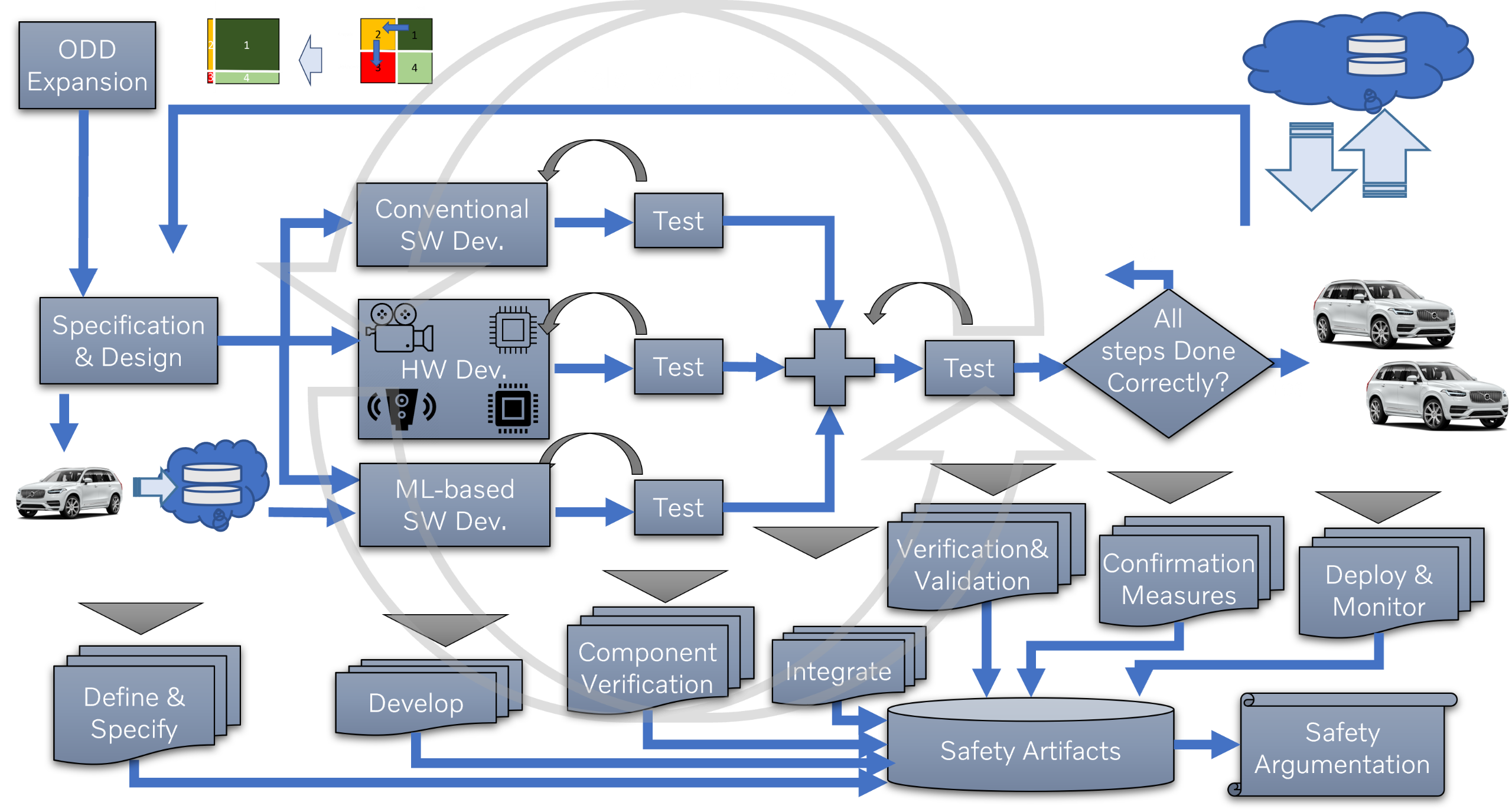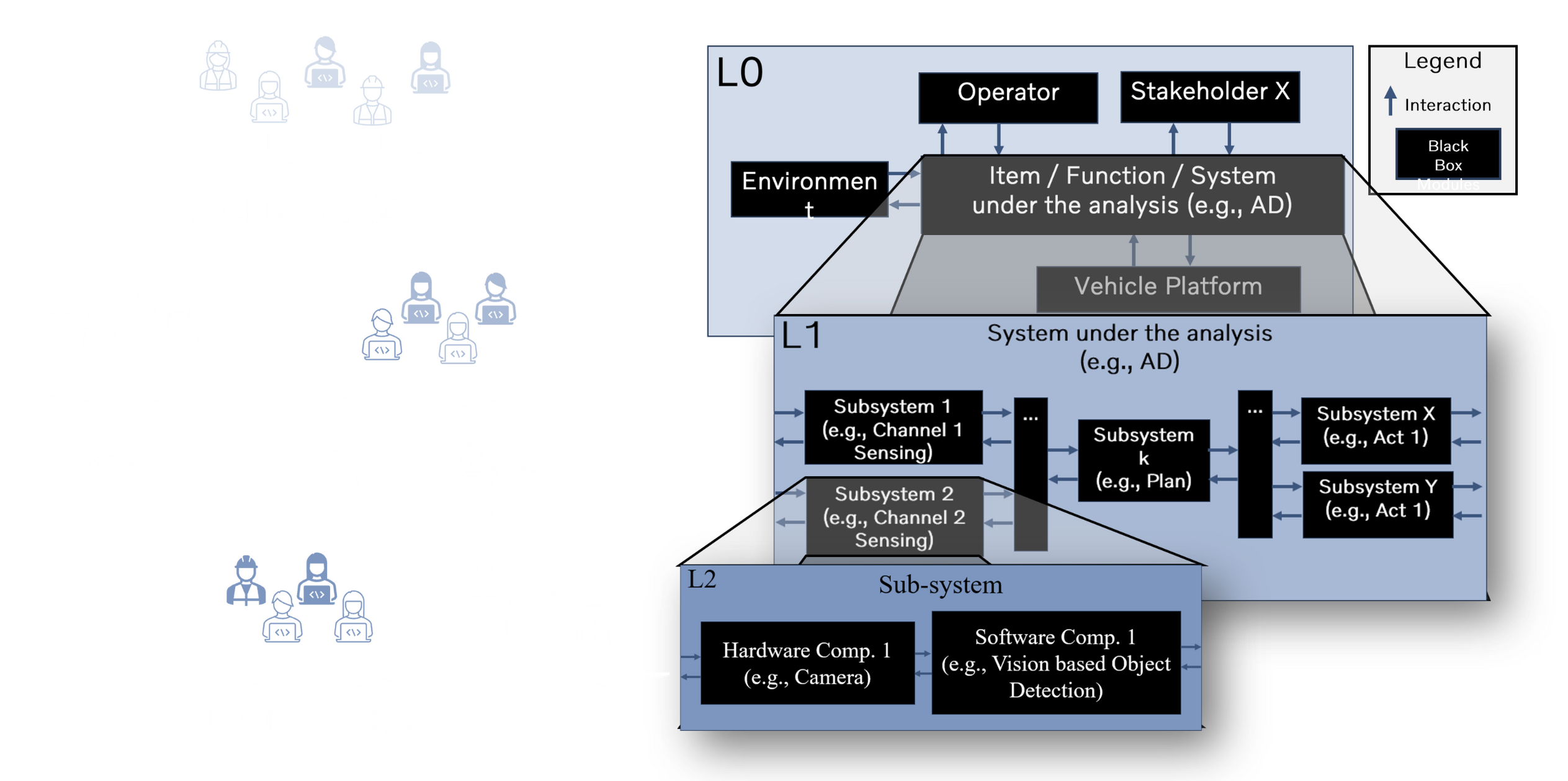Ali Nouri
AI Researcher @ Chalmers University of Technology
Arguing Safety of Autonomous Vehicle @ Volvo Cars
Research Goal:
Accelerating DevSafeOps for Autonomous Driving Software.
Collaboration between Volvo Cars, Zenseact, and Chalmers.
Recent Event: Public Defence
Topic: Accelerating the Design Phase -
Towards DevSafeOps for Autonomous Driving Software
Opponent: Prof. Philip Koopman, Carnegie Mellon University, US
Research Abstract
Background: The safety of Autonomous Driving (AD) remains a barrier to its widespread adoption, as evidenced by recent incidents. Factors such as the complex environment, evolving technologies, and shifting regulatory and customer requirements necessitate continuous monitoring and improvement of AD software (Fig. 1). This is a process that may favor software and system engineering supported by DevOps. The iterative DevOps process is crucial, serving two purposes: satisfying customer demands through continuous improvement of the function and providing a framework for timely responses to unknown bugs or incidents. However, any update to the software must follow rigorous safety processes prescribed by standards, regulations, or the state of the art in industry. Incorporating these safety activities into the DevOps forms an iterative process called SafetyOps. These necessary activities, although vital for safety assurance, inherently lead to a compromise in rapidity.
Research Goal: In this work, we initially identify the challenges in the rapid SafetyOps in AD development and then explore existing solutions. Subsequently, we propose two approaches for accelerating the primary activities in the AD development, which are requirement engineering and safety analysis.
Fig. 1: DevOps loop in safe AD development (Publication A)
Methods: To address each research objective, diverse research methods are utilized. Interview studies and a systematic literature review are conducted to identify the challenges and research gaps. Then, design science, interview study, and a case study are employed for the proposed approaches.Results: Initially, the challenges and research gaps related to each essential activity for the safety of AD are identified (Papers A and B). The proposed solutions in literature are identified and mapped to the challenges (Paper B).
Then, two approaches are proposed for the rapidity of safety analysis, which is the initial step in the development. We adapt System Theoretic Process Analysis (STPA) for distributed development within automotive system engineering, which is our suggestion to approach the first challenge (Paper C, and Fig. 2). As an alternative approach, a Large Language Model (LLM)-based hazard analysis risk assessment prototype is developed (Fig. 3) and evaluated to enable automation
(Papers D and E).
Fig. 2: Distributed development (Publication C)
Conclusions: There are multiple challenges in achieving rapid SafetyOps in AD development. The design phase, as a stepping stone of development, was underexplored with respect to methods for rapid updates in its artifacts. In one approach, we propose adapting STPA for multiparty distributed development to increase the speed of SafetyOps. Subsequently, we explore the possibility of using LLMs to perform design phase activities with reduced engineers’ involvement. These two proposed approaches have the potential to contribute to an increase in speed in the design phase, one by enabling distributed development, and the other by automation.
Fig. 3. LLM-based HARA, utilizing a pipeline of subtasks, each managed through a specific prompt. The item definition is imported (top-left), and the HARA results are exported (bottom-right). In the second row of the HARA table, the relationship of each column to the prompts is summarized. (Publication D)
Current research: We are currently designing and developing an LLM-based prototype for closed-loop automated code generation. In this project, a simulation environment serves as an abstract world model, providing feedback to the LLM to assist in generating the next version of the software. The following video showcases the designed prototype and demonstrates the evolution of the code through one iteration, where feedback from the simulation model is used to improve the generated software.
Recent Award
CHALLENGE AWARD IN RE '24: "Expanding the Frontiers of RE"
Recent Publications
- On Simulation-Guided LLM-based Code Generation for Safe Autonomous Driving Software
- Large Language Models in Code Co-generation for Safe Autonomous Vehicles
- Engineering Safety Requirements for Autonomous Driving with Large Language Models
- The DevSafeOps Dilemma: A Systematic Literature Review on Rapidity in Safe Autonomous Driving Development and Operation
- Welcome Your New AI Teammate: On Safety Analysis by Leashing Large Language Models
- An Industrial Experience Report about Challenges from Continuous Monitoring, Improvement, and Deployment for Autonomous Driving Features
- On STPA for Distributed Development of Safe Autonomous Driving: An Interview Study
- How Can Generative AI Enhance Software Management? Is It Better Done than Perfect?
- Comparing Optical Flow and Deep Learning to Enable Computationally Efficient Traffic Event Detection with Space-Filling Curves
Patent (publicly available)
- Training and operating an object detecting system for a vehicle
- Method for managing a user demand-based operational design domain expansion for an automated driving system of a vehicle
- Methods and systems for adapting an automation system in a vehicle
Selected Previous Presentations
- MIT 2022 STAMP Workshop - A feasibility study on the application of STPA method in AD
- Auto AI USA (San Francisco) - Accelerating AV DevSafeOps - Large Language Models as a potential approach
- Autonomous Vehicle Technology Expo 2024 - Leashing AI: On Challenges and Solutions in Autonomous Vehicle Safety Assurance
- CAIN 2024 - Welcome Your New AI Teammate: On Safety Analysis by Leashing Large Language Models
- Keynote @ SRToITS 2025 is in conjunction with SAFECOMP 2025 - DevSafeOps for Autonomous Driving: Generative AI - Silver Bullet or Just Buzz?
Supervision Activities
| Title (Link) | Year |
|---|---|
| Master’s thesis: Comparison of STPA with FMEA for analyzing safety of autonomous driving system | 2023 |
| Master’s thesis: Autonomous Pipeline for Generating Vehicle Behavior Logic, Leveraging Generative AI and Simulation | 2024 |
| Master’s thesis: Space-Filling Curve-Based Traffic Event Detection Using Deep Learning and Optical Flow | 2024 |
Experiences
2022 - Current: Autonomous Vehicle Researcher (PhD Candidate) @ Chalmers University of Technology & Volvo Cars
2018 - Current: Autonomous Vehicle Senior System Safety Engineer @ Volvo Cars
2015 - 2018: Safety Manager @ exida
Education
2022 - current: PhD candidate @ Chalmers University of Technology
2014 - 2015: Master Thesis @ ETH Zurich - Dynamic Capability Analysis and Arm Controller Development for an In-Situ Fabricator
Without stability control
With stability control
2012 - 2015: Master of Science in Mechatronics, Robotics, and Automation Engineering @ Politecnico di Torino



